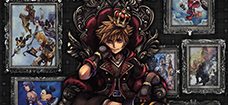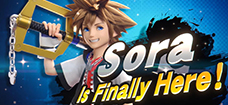How did you pick the worlds? You have the Hunchback of Notre Dame world; the Musketeers, which isn’t as well known; and Fantasia, which is a key film.
Tai Yasue, Director: Each world has its difference and meaning. Notre Dame had a lot of user feedback. A lot of users wanted Notre Dame to be added, so we listened to them and we put that in. For The Three Musketeers, we thought it would just be interesting that Mickey, Donald and Goofy were dressed differently. [They] were sort of themselves but in a different way. We thought that would be sort of fresh.
For Fantasia, we wanted players to play with the music. We have some nice classical music, so I guess a music-centric game.
I remember reading in another interview that you were originally thinking about having the original Tron world in the game, and then you decided to go for [Tron] Legacy. Sora was supposed to go to the original Tron world and Riku would go to Legacy. Can you tell us about that?
That was Fantasia and Fantasia 2000, but we also considered Tron, too. I think we wanted Tron: Legacy at the very beginning, but for Fantasia and Fantasia 2000, we were thinking about that. Sora was going to go to Fantasia and Riku was going to go to Fantasia 2000.
We wanted Sora and Riku to go to the same world but in a different way, but at the very end, we looked at a lot of music and locations in Fantasia and thought that was really rich, and we wanted to concentrate on the best locations, so we concentrated on one Fantasia.
A lot of fans are happy to see The World Ends With You characters in Traverse Town. It was kind of cool how you had Joshua explain what was going on between Sora and Riku.
Well, actually, Nomura wanted The World Ends With You added and we wanted to sort of change Traverse Town. We always use that world, so we wanted to make it fresh and new in a way that would work. The fields for example were buildings that looked sort of like Shibuya with a lot of graffiti and we had a change of look.
For previous Kingdom Hearts, we’ve used a lot of Final Fantasy characters and we wanted a departure from that for Traverse Town, so The World Ends With You was a natural selection.
What was it like programming the AI for all the different Dream Eaters?
We actually used a different AI system for [Kingdom Hearts] 3D. During Birth by Sleep, it was script-based, but for 3D, we used a new game flow tool. For one Dream Eater, there’s actually several “characters”. Several personalities. So if you have your mascot characters, they would do different things. We were able to have the freedom to make a wide variety of tweaks and changes for the Dream Eaters.
For the mascot Dream Eaters that you carry along with you, they actually change along the way if you pet them and stuff. So it really depends on the character. They might just sleep, they might be really useless, or they might be angry all the time and attack a lot. Overall, there was a lot more AI than Kingdom Hearts: Birth by Sleep.
What are you going to do with all that AI for a future Kingdom Hearts game? What are you going to do with all this tech that you developed for 3D?
Well, there are a lot of ideas coming along. I’m not really in a position to talk about the next Kingdom Hearts, but I think AI is something that we really have put more power into. For the next-gen consoles like the PS3 for example, there’s a lot more things you can do compared to the 3DS, just because there’s a lot more CPU power. So, if we were to make a game for the next-gen [systems], for the PS3 for example, we would rather like to utilize that part.
Kingdom Hearts 3D's combat is fun, but what drove me crazy at first was the "Drop" mechanic. In the middle of the first boss fight in Traverse Town I got "dropped," so I tried to switch back really quickly and the boss' health regenerated.
[Laughs] Nomura wanted it to be a bit thrilling in a way, so we added a time limit. It's a little bit different in the North American version. We tweaked it, it's not a big difference, but Sora and Riku's HP will become full at the beginning of the boss battle, so if you're dying, you can start over, too.
We didn't really want to lose the character of the game. It's one of the parts that's sometimes stressful. When you're successful, when you beat the boss at the last few seconds it feels really good.
I got the hang of it later on and how you can use it to boost your character. That's when I felt it worked, but at the beginning when someone doesn't know what's going on, it's like, "Awww..."
[Laughs] As you go along, you earn a lot of drop bonuses, so we wanted the characters cooperating. A feel for cooperation, and we did that using the Drop system, I think.
While Kingdom Hearts 3D uses the deck command system, I found myself using more Flowmotion attacks. They seemed to overpower everything. You can bounce back and forth between enemies, and it negates almost all of your commands.
At the start of the game, the Flow-Motion may feel powerful, but as you progress, at the later stages, the Deck Commands are really powerful. Flowmotion is used more when you want to escape, so there's a difference in meaning and strategy. At the very beginning, really, we wanted to introduce Flowmotion, so the Deck Commands are a little weaker, but as you progress, that balance changes.
I see what you mean because in the beginning I used Flowmotion a lot. One of the most interesting thing in Traverse Town, when you go underground, there's all of those grind rails. I know you can ride those and find the correct path to the top, but I just jumped all the way, by doing an infinite wall-jump using Flowmotion. Did you plan for that?
Oh, we did. We planned for that. Kingdom Hearts isn't a game where you have to do one single thing to clear it. We wanted options-you can go this way or that way. It's not just one route, you can go up the wall, you can slide down a ramp. You don't need only need to use the Deck Commands, you can use Flowmotion or you can use Reality Shift. We just wanted to provide a wider range of options and really wanted users to pick which strategy they use.
In some places, though, like Prankster's Paradise, I feel like it almost "breaks" the level. Like when you flip the world upside-down. All the really good treasure chests are at the top, but you can avoid doing all the platforming by horizontal wall-jumping across.
I guess, but if you want the treasure chests, you have to actually switch it over. One of the concepts for Flowmotion is a lot of freedom. And when we say "freedom," we wanted the player to feel free to do what they want to do. You could use a lot of map gimmicks, but if you don't want to you can use Flowmotion too.
What other tweaks did you make to the North American version, other than to the Drop mechanic?
I think that's just the major change; we haven't changed that much. We wanted the Japanese version and North American version to be pretty similar. I think there's a Drop bonus that was added. I think it's called "Drop Speed Down" in Japanese, but I don't know what the English name is. We added the drop bonus and that's about it. Not a lot of major changes.
Going back to Prankster's Paradise when you're playing as Riku, all the time, there's this wall of text that tries to explain Chain of Memories. Kingdom Hearts started with a very simple mythology that's gotten more complicated over time. What's your view on how to make the mythology more accessible?
I really think it depends on the player. Some really want to know everything. For [Kingdom Hearts] 3D, you've got the Mementos, and you don't have to see them if you don't want to. You can skip it. At the same time, if you want to read it, you can go in and see it.
We developed the game so that hardcore players who want to understand it can do that, and people that just want to play lightly - who play all the Disney worlds, experience the Disney story-they don't really have to see all the deep stuff.
There have been 10 years of Kingdom Hearts and kids who started playing the series when they were 10 are 20 now. Since we're still focusing on the same characters, how are you going to make the Kingdom Hearts story follow an audience growing up with the franchise.
In 3D, we introduced the Memento system to cover that. In future titles, we're going to really have to think about that.
I think for Kingdom Hearts you can really enjoy the lighter aspects. It's about coming to terms with Riku's darkness. It's about friends. There are a lot of easy themes too and when you go to a Disney world each one has a story that is really accessible. If you want to understand everything it might be a little complex, but if you want to play lightly I think that's possible too. Obviously, we want new players to access the game in a way so we're going to have to think about that. I can't really talk about our new titles yet, but for 3D we tried to do that with the Memento system.
Do you have any other plans for the 10th anniversary?
Not at the moment, no. [Kingdom Hearts] 3D is definitely our 10th anniversary title.
Without spoiling it, can we talk about the ending a bit?
I would just like to say that, this time the game is more centered on Riku and how he comes to terms with the darkness. Kingdom Hearts 3D really connects to the next Kingdom Hearts-Kingdom Hearts 3. And in a way, I think you'll be able to see a glimpse of the future by playing Kingdom Hearts 3D.
|








